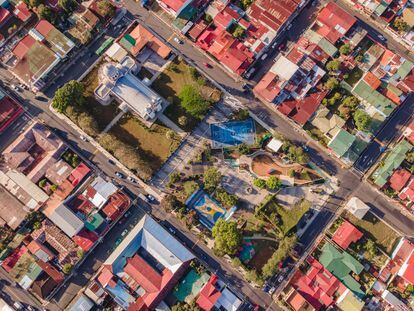EL PAÍS offers the América Futura section openly for its daily and global information contribution on sustainable development. If you want to support our journalism, subscribe here.
What if the development model were not based on GDP, but on the sweetness, empathy and happiness experienced by all the human and non-human inhabitants of a territory? What if this development was measured in biodiversity indicators, For example, how many bees, hummingbirds and butterflies return and begin to inhabit and connect the sidewalks, parks and balconies of the city? This model is far from being a utopia. A small city in Costa Rica, Curridabat, with almost 30,000 inhabitants, has done experiments and has managed to declare itself a true sweet city for everyone.
“In Latin America we do not have so many economic resources, but we do have many natural resources; however, we try to copy development models from cities in other latitudes that have nothing to do with our reality. Knowing that natural resources are so important, we in Curridabat put them at the center,” explains Irene García Brenés, urban planner and environmental consultant who has worked with the mayor's office and local authorities of this city to bring a change of vision not only in the rulers, but in the citizens.
After holding popular consultations in more than 50% of the territory, work began on a new neighborhood idea that included as a first measure the recovery of sidewalks and parks, but not with a vision that would benefit only the human inhabitants, but rather to everything around. “We asked ourselves what the real experience of the citizens was, but when we did this we thought about all the citizens, the bees, the dogs, the plants, the inhabitants of space. We have to overcome the paradigm that nature is important because it serves us. We recognize that all living beings have rights, that we have to respect their space, their place and that we are an interconnected system. That is the message that differentiates us. Beyond being a green city because that represents health for its inhabitants, it is a sweet city because empathy runs through all our relationships,” adds Irene García.
After consulting several experts and working hand in hand with the National Museum of Costa Rica, Curridabat created a guide to sweet plants with precise indications of where they should be planted (sidewalk, balcony, pot, park) and what ecosystem services they provided. Thus, this recovery was not only going to change citizens' perception of public space due to the landscape effect and the experience of planting and watching a plant grow, but it was going to recover the habitat and the pollination work of what they called “the sweet gang”: bees, hummingbirds, butterflies and bats. In a world that raises alarms about the “pollinator crisis,” Curridabat was going to convert its public spaces into safe havens for these vertebrates and invertebrates that globally are responsible for pollinating more than 1,200 types of crops. In fact, 75% of the world's food crops depend on them.
“Beyond the landscape effect, this project has helped deepen everyone's contact with nature. It has helped generate ecological connectivity for many species and host other new species. But this has matured to the point that today sidewalks and parks provide other services, such as being water sponges, an urban model that invites us not to get rid of the rainwater that falls as quickly as possible, but rather seeks to drop of water that falls in Curridabat stays in Curridabat throughout its entire cycle,” explains, for his part, Huberth Méndez, an architect specialized in decolonizing the hegemonic paradigms of traditional urbanism in Latin America, through the promotion of the connection with the nature and ecosystem services.
This project, which highlights the great potential for transformation that local governments have, has also opted to carry out other actions that amplify this new narrative. In addition to doing the pedagogical work of going to schools to talk about the importance of pollinators, of having sweet days at fairs where residents commit to taking care of a plant, of making hotels for insects in the most visited parks and raising indicators of biodiversity to know what species are available in the city, they have developed an ambitious project giving composters to all citizens who are up to date with their taxes.
The composting program, as told the official page of the city, “seeks to educate citizens in this technique of transforming organic waste to obtain compost, a natural fertilizer that serves to provide nutrients to the earth.” Among the benefits of composting, the reduction in the amount of garbage in the city, the fixation of carbon dioxide, the generation of new soil to plant in pots and recovered patios, and the fertility of the territory stand out.

The idea that runs through the entire project, that of putting nature at the center and seeing humans as another link in that nature, seems an urgent focus in more Latin cities than despite being in countries extraordinarily rich in biodiversity, – Costa Rica alone, with its small area, is home to 5% of the world's biodiversity – they have been built completely disconnected from and contrary to those riches.
“Costa Rica, as is the case with many other countries in Latin America, is crossed by a deep contradiction. We are a country that has been at the forefront of many environmental changes globally, we were the first to pay to preserve forests, to protect conservation areas, but in cities this does not happen. San José is known as one of the ugliest cities in the region and this antagonism is very strange, it should not continue, cities also have to be the place of life,” concludes Irene García.
#sweetness #model #urban #development